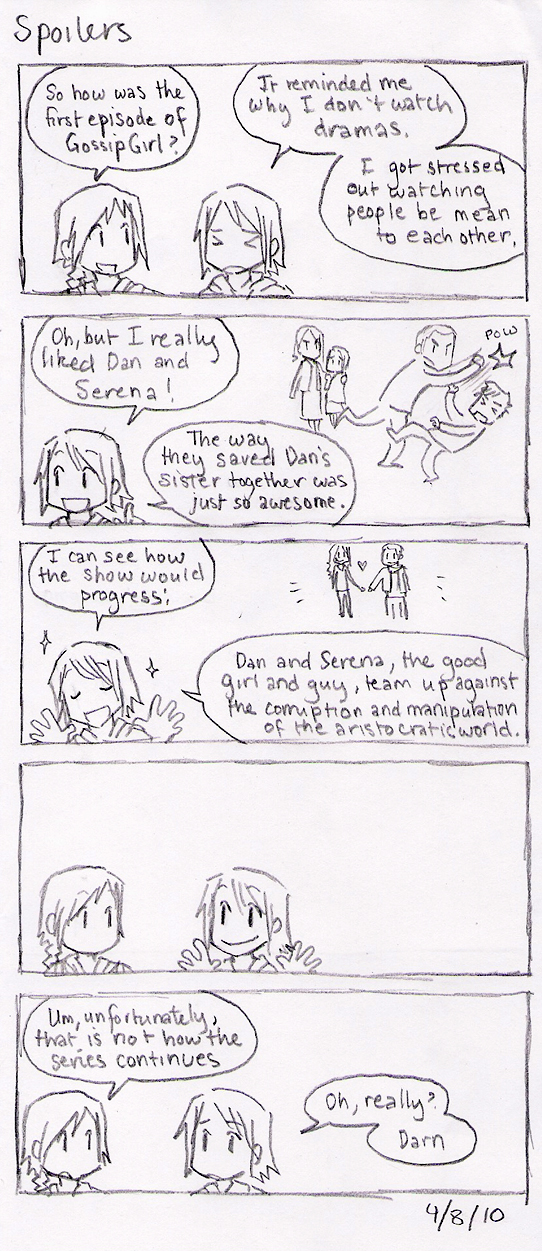Spoilers
April 8th, 2010Thanks everybody for the thoughtful responses on the last post and the support for the comics 🙂
This week we were assigned to read Digital Storytelling by Carolyn Miller and Playing Dress Up by Louisa Stein. In addition we were to watch the pilot episode of the TV show Gossip Girl, and an episode of a soap opera of our choice.
I hardly ever watch dramas. I can’t stomach them. I would much rather watch heroic, good-triumphs-over-evil type stories, and tend to avoid narratives that outline the bad side of humans along with the good.
But even as I was watching the gossip fed to me by the mysterious Gossip Girl, I also felt myself perking up my ears for “juicy” bits of information and hanging on to the details of schoolgirl controversy. Gossip Girl does an excellent job of immersing the viewer, because it literally lets the user become one of the many followers of Gossip Girl. Just as many of the in-show characters are keeping up to date with her latest posts, so is the TV audience. There really is very little difference between the real-life followers and the fictional ones, and I think this is the key thing that makes Gossip Girl’s narrative engaging.
Out of curiosity, I googled for Gossip Girl’s offical blog. Sure enough, there is one hosted on the CW website (http://gossipgirl-blog.cwtv.com/) and it is indeed written by Gossip Girl. I had never really thought about transmedia before, so this blog did an excellent job illustrating to me its power. I was looking at the real Gossip Girl’s blog. The posts are written as if these characters are real, and actual (I think!) readers post comments (mostly outbursts of “noooo how could they break up”) as they would on a real blog, commenting on these events that “happened”. The functional presence of something that is supposed to be fictional causes the fictional world to spill into the real one, and the ability of a fan to participate in the fictional thing causes the real world to spill into the fictional one — a strong, two-way, interactive connection.
So far, I feel like the examples of transmedia use that I have seen are used for properties that have some basis in the real world. The Matrix, Batman, Gossip Girl, Harry Potter… in all of these, there is a character that moves from the world we live in to the fictional one (Neo was a normal guy, Bruce Wayne lives in a fictional city that’s close enough to real ones, Gossip Girl takes place in actual New York, and Harry Potter actually lives somewhere in Britain while he’s not at Hogwarts). Is this a requirement? Is there a way to use transmedia for a property like Lord of the Rings? I feel like getting a phone call or a text message from Frodo Baggins would seem very bizarre and out of place. It seems like it is necessary for a fictional world to at least in part be similar to our real one for this transmedia technique to be effective. Miller, in Digital Storytelling, talks about the definition of transmedia: each media form relates a different part of the story or relates the story in a different manner, all the while expanding on the core material. She also says that at least one of the media forms must be interactive, so that the audience can participate. But there is no immersion if the audience can participate in a way that makes sense (commenting on Frodo’s blog posts or posting on Sam Gamgee’s Facebook wall hardly makes sense!). So, perhaps we should add that the interactive media form must allow fans to participate believably (maybe an alternate reality game set in New Zealand called “Help Frodo Take the Ring to Mordor”? Maybe not…)

 RSS
RSS






The comics continue to be a great touch.
I too am a fan of “heroic, good-triumphs-over-evil type stories”…but the best ones necessarily have more meat on the evil, rooted in very human flaws and motivations. On the other hand, “people being mean to each other” sadly describes most television dramas too well – they use this to create cheap tension instead of developing deeper and more complex dramatic forces. The result is shallow, perhaps entertaining, but not particularly elevating or illuminating.
The “basis in the real world” which you identified is pure Joseph Campbell. This is what he refers to as the Departure – the hero begins in mundane normality, and is no one special until the heroic Call. Many stories implement this by beginning with everyday life as we experience it – but the same narrative device is present in Tolkien’s “Lord of the Rings” despite the fantastical setting. Frodo is, at first, a simple burgher whose fondest ambition is to have a nice pipe after his dinner. The fact that his normality is fraught with metaphor as a result of the surrounding fantasy only serves to reinforce the Campbellian device.
Wow – good thinking looking at the real GG blog. I personally can’t imagine reading a blog that I knew was fictional and commenting as if the events were actually happening. That’s a great illustration of the kind of immersion people seek from media these days! I wonder why it is that simply watching a show or reading a book isn’t enough to satisfy our imaginations anymore? Or maybe it does satisfy us, and we pursue the extra immersion just for entertainment’s sake!
I agree that properties using transmedia tend to have a basis in the real world — in fact, I think I mentioned it in my blog. It concerns me how fantasy and reality begin to overlap, because it gives producers a significant measure of influence on our real lives. Breaking down the fourth wall is a great way to engage the audience, but if we’re not careful, we might lose our individual identities and values. I’m not saying that media producers will control our minds, but they are certainly effective at dictating what’s socially acceptable. When we see characters put in situations similar to our own, and see them triumph by handling them in a certain way, we are prone to do the same — perhaps even subconsciously. I like how you noticed that the show transformed you into a follower of Gossip Girl — that’s the power of the media, spilling over into our lives.
I agree with James (fluidic) about enjoying stories with more “meat” on the evil, but I feel like the character development needs to be sophisticated as well. I like shows that narrate *how* a character came to be who they are, so we can understand their flaws and motivations. That’s why I can’t stand it when characters discuss flaws directly — *show* us, don’t tell us! “People being mean to each other” can be a *component* of a deep story: they often belie larger problems in a subtle way. That’s what can make a soap opera interesting — when you have to figure out *what* a character’s deeper flaws and struggles are before you understand how he/she is trying to resolve them.
By the way, I just realized that your blog is the only transmedia blog in this class. While the rest of us use only blog entries, you employ comics! I might try this out on my blog as well; stay tuned!
definitely an interesting way of thinking about reality and unreality spilling into each other. it seems that the gossip girl blog is an example of a growing trend, though–i think more and more people like to feel that there is barely anything between them and the property they’re engaged in (passively watching or otherwise). the blog seems a way to accomplish something games do without the participant even being aware of it: immersion, as you spoke of. it seems to me that this desire to feel immersed in the worlds we observe probably has a lot to do with out technology age in general since people have more and more ways to connect to each other and paradoxically end up less and less connected. having a blog like gossip girl’s is a good way to make people feel grounded in something, especially when they don’t even know what’s happening in their own family and friends’ lives without checking their respective facebooks.
i think the transmedia properties we engage in shift from being grounded in fantasy to reality as we grow older because we’re expected to focus on what’s real to improve our productivity and attention span. when i read lord of the rings or harry potter as a kid, my mind would be lost in those books for days or weeks on end, and i wouldn’t be able to focus on much else. which would sort of fuck up the economy as adults. so we shift to a projected reality (not real for most people, but theoretically possible) to escape the boredom and mundanity of the 9 to 5.
i dig the comics.
Yet again, I find the comics at the beginning a great way to introduce this week’s topic. Speaking of which, you did an excellent job of describing the nature of transmedia worlds, both in relation to Gossip Girl and others. I personally never would have thought to visit the actual blog, nor could have imagined the level of engagement that you found there. However, I was more interested in your thoughts on how some media franchises would face more difficulties in engaging fans in a transmedia manner than others. Using Lord of the Rings, it would be much more difficult to send a scroll or something to every fan instead of just a call. But I believe that there are many board and video games that allow fans to engage with the property, so it could be more that the creators need to engage in fans in different ways, depending on the franchise’s original format or context.
I have to say: your blog and comics are sooo cool and I really love them. Good start for a topic with your own livily presentation through your lovely drawing.
Then, I’m pretty impressed by your observation and understanding to the Gossip Girl blog. I went to see that after looking through your blog and the atmosphere created in the blog did give the illusion that charaters and news were actually from the real world and drove my mind to consider them by empirical values. The entries of the blog were mostly begun with “Spotted..” just as in the episodes and viewers also perceived that they just got a peek to the superior circle of those upper east-sider high school teenagers. I have to admit that the blog is definitely a clever transmedia to the episode and a successful tool for marketing.
are you taking a cool class that has all these theories?
yup! Popular Culture: Constructing Transmedia Worlds :3 taught by Wanda Gregory